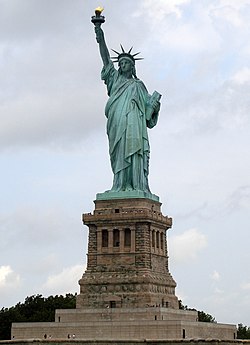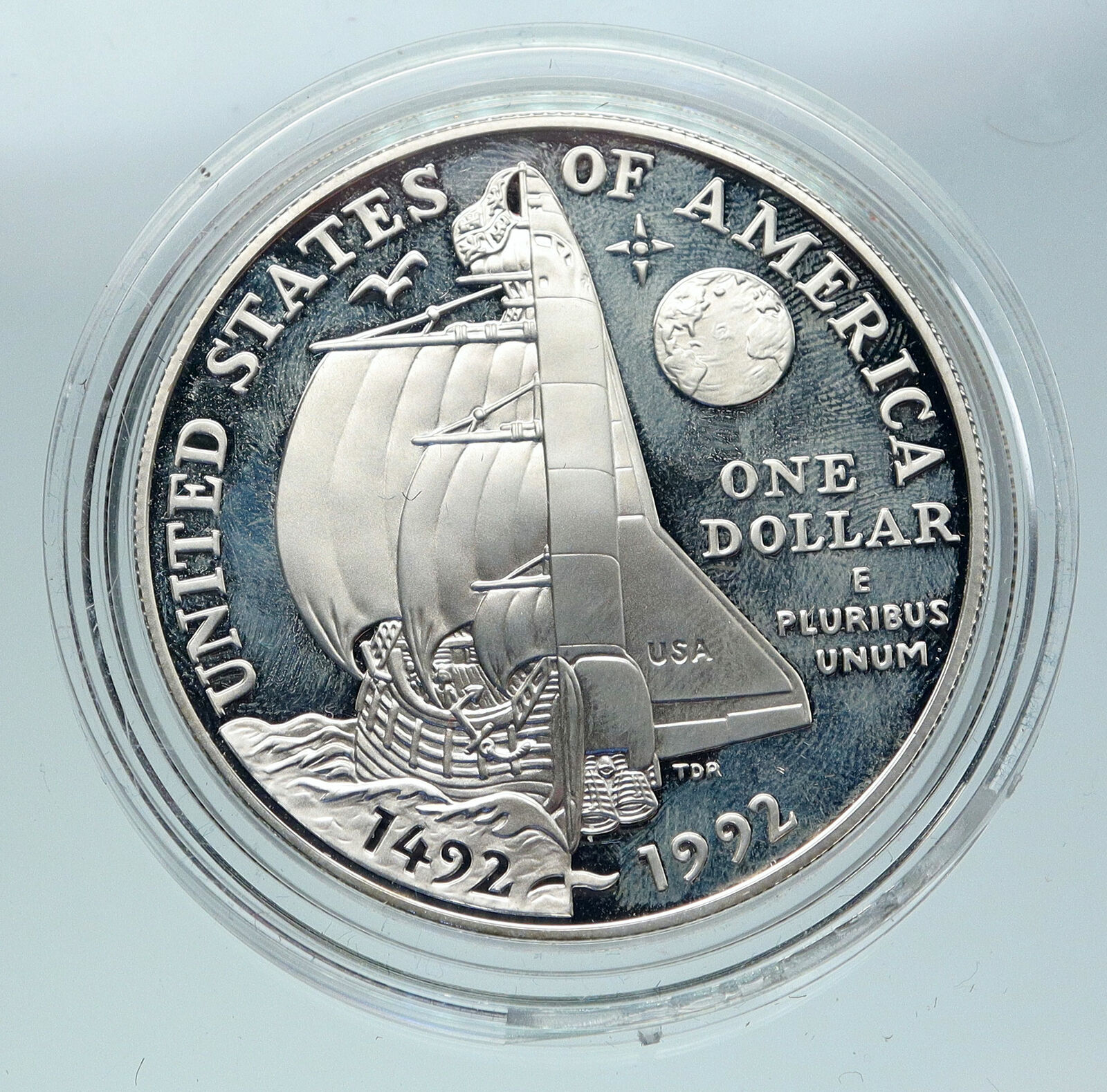|
United States of America – Statue of Liberty on Ellis Island
1986 Silver Dollar 37mm (26.67 grams)
Reference: KM# 214
LIBERTY ELLIS ISLAND GATEWAY TO AMERICA IN GOD WE TRUST 1986, The Statue of Liberty with the main building of Ellis Island in the background.
UNITED STATES OF AMERICA GIVE ME YOUR TIRED, YOUR POOR, YOUR HUDDLED MASSES YEARNING TO BREATH FREE E PLURIBUS UNUM ONE DOLLAR, The statue’s hand with a lit torch are depicted with the concluding words of Emma Lazarus’s poem The New Colossus.
Coin Notes: The Statue of Liberty Silver Dollar was struck in proof at the San Francisco Mint and in uncirculated at the Philadelphia Mint. The coins had a maximum authorized mintage of 10 million, and eventually sold more than 70% of that amount. The silver dollar was sold individually or as part of a two, three, or six coin set. The coins could initially be purchased at a discounted “pre-issue” price before regular pricing went into effect.
You are bidding on the exact item pictured, provided with a Certificate of Authenticity and Lifetime Guarantee of Authenticity.
 The Statue of Liberty (Liberty Enlightening the World; French: La Liberté éclairant le monde) is a colossal neoclassical sculpture on Liberty Island in New York Harbor in New York, in the United States. The copper statue, a gift from the people of France to the people of the United States, was designed by French sculptor Frédéric Auguste Bartholdi and its metal framework was built by Gustave Eiffel. The statue was dedicated on October 28, 1886. The Statue of Liberty (Liberty Enlightening the World; French: La Liberté éclairant le monde) is a colossal neoclassical sculpture on Liberty Island in New York Harbor in New York, in the United States. The copper statue, a gift from the people of France to the people of the United States, was designed by French sculptor Frédéric Auguste Bartholdi and its metal framework was built by Gustave Eiffel. The statue was dedicated on October 28, 1886.
The Statue of Liberty is a figure of Libertas, a robed Roman liberty goddess. She holds a torch above her head with her right hand, and in her left hand carries a tabula ansata inscribed in Roman numerals with “JULY IV MDCCLXXVI” (July 4, 1776), the date of the U.S. Declaration of Independence. A broken chain lies at her feet as she walks forward. The statue became an icon of freedom and of the United States, and a national park tourism destination. It is a welcoming sight to immigrants arriving from abroad.
Bartholdi was inspired by a French law professor and politician, Édouard René de Laboulaye, who is said to have commented in 1865 that any monument raised to U.S. independence would properly be a joint project of the French and U.S. peoples. Because of the post-war instability in France, work on the statue did not commence until the early 1870s. In 1875, Laboulaye proposed that the French finance the statue and the U.S. provide the site and build the pedestal. Bartholdi completed the head and the torch-bearing arm before the statue was fully designed, and these pieces were exhibited for publicity at international expositions.
The torch-bearing arm was displayed at the Centennial Exposition in Philadelphia in 1876, and in Madison Square Park in Manhattan from 1876 to 1882. Fundraising proved difficult, especially for the Americans, and by 1885 work on the pedestal was threatened by lack of funds. Publisher Joseph Pulitzer, of the New York World, started a drive for donations to finish the project and attracted more than 120,000 contributors, most of whom gave less than a dollar. The statue was built in France, shipped overseas in crates, and assembled on the completed pedestal on what was then called Bedloe’s Island. The statue’s completion was marked by New York’s first ticker-tape parade and a dedication ceremony presided over by President Grover Cleveland.
The statue was administered by the United States Lighthouse Board until 1901 and then by the Department of War; since 1933 it has been maintained by the National Park Service. Public access to the balcony around the torch has been barred since 1916.
There are several plaques and dedicatory tablets on or near the Statue of Liberty.
- A plaque on the copper just under the figure in front declares that it is a colossal statue representing Liberty, designed by Bartholdi and built by the Paris firm of Gaget, Gauthier et Cie (Cie is the French abbreviation analogous to Co.).
- A presentation tablet, also bearing Bartholdi’s name, declares the statue is a gift from the people of the Republic of France that honors “the Alliance of the two Nations in achieving the Independence of the United States of America and attests their abiding friendship.”
- A tablet placed by the American Committee commemorates the fundraising done to build the pedestal.
- The cornerstone bears a plaque placed by the Freemasons.
- In 1903, a bronze tablet that bears the text of Emma Lazarus’s sonnet, “The New Colossus” (1883), was presented by friends of the poet. Until the 1986 renovation, it was mounted inside the pedestal; today it resides in the Statue of Liberty Museum, in the base.
- “The New Colossus” tablet is accompanied by a tablet given by the Emma Lazarus Commemorative Committee in 1977, celebrating the poet’s life.
A group of statues stands at the western end of the island, honoring those closely associated with the Statue of Liberty. Two Americans-Pulitzer and Lazarus-and three Frenchmen-Bartholdi, Eiffel, and Laboulaye-are depicted. They are the work of Maryland sculptor Phillip Ratner.
|





 The Statue of Liberty (Liberty Enlightening the World; French: La Liberté éclairant le monde) is a colossal neoclassical sculpture on Liberty Island in New York Harbor in New York, in the United States. The copper statue, a gift from the people of France to the people of the United States, was designed by French sculptor Frédéric Auguste Bartholdi and its metal framework was built by Gustave Eiffel. The statue was dedicated on October 28, 1886.
The Statue of Liberty (Liberty Enlightening the World; French: La Liberté éclairant le monde) is a colossal neoclassical sculpture on Liberty Island in New York Harbor in New York, in the United States. The copper statue, a gift from the people of France to the people of the United States, was designed by French sculptor Frédéric Auguste Bartholdi and its metal framework was built by Gustave Eiffel. The statue was dedicated on October 28, 1886. 




